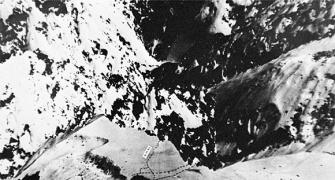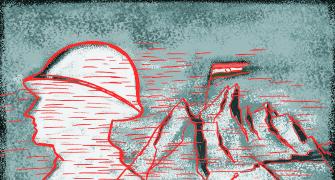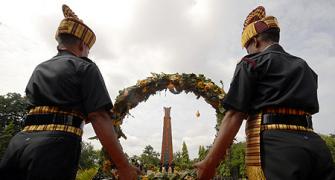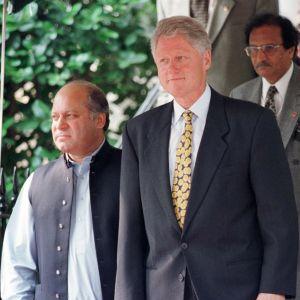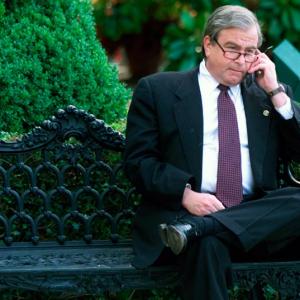'Vajpayee was the first prime minister to visit the battlefield at the height of conflict,' recalls Colonel Anil A Athale (retd).
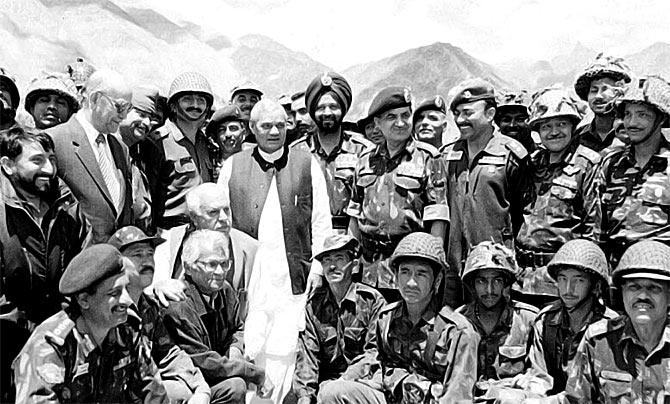
While then prime minister Atal Bihari Vajpayee was in Pakistan in February 1999, the Pakistan army led by General Pervez Musharraf was preparing to intrude in Kashmir, seize peaks in Kargil with the grandiose aim of forcing India out of Kashmir militarily.
Instead of treating the Pakistani nuclear capability as a deterrent against aggression, its military thought of using it as an umbrella to carry out covert aggression.
In order to keep the restless militia groups busy and political opponents quiet, Pakistani strategists suggested a scheme wherein the army, supported by militia groups, would establish a small enclave across the Line of Control at a location which would be tactically strong and hurt India.
They believed that India's conventional military superiority has been neutralised by Pakistan's nuclear weapons. There was therefore little risk of their limited plan escalating into a full-fledged war.
They were sure that this would result in the intervention of the United States and the United Nations and a reopening of the Jammu and Kashmir issue to Pakistan's advantage.
Nawaz Sharif, then the Pakistan prime minister, accepted the concept in its broad outline.
Pakistani military planners selected a place of intrusion along a 140-km stretch of the Line of Control, which overlooks NH1A in the Kargil area.
Thousands of civil and military vehicles use this road between the months of April and October.
The uninhabited LoC runs parallel and north of the road at a height of about 17,000 feet. Military outposts of both India and Pakistan are located here in the summer and vacated in the winter.
From April 1998 onwards, the Pakistani military, using Skardu as its base, moved a brigade group (about 5,000 regulars) into the area and began preparations along its side of the LoC.
Pakistan collected about 1,500 infantrymen, artillery guns, anti-aircraft missiles and about 500 militia.
Once the men were fully acclimatised to operate at heights above 15,000 feet, each base began erecting sheds on the slopes close to the top of the dominating features on the Pakistani side of the LoC. These were located so that they could not be seen from the Indian side of the LoC.
The snows melted early in April 1999. Using the bases as launching pad, Pakistan moved a mixed force of about 100 regulars and militia to the shed area. Half the number began preparing strong defences 500 metres on the Indian side of the LoC.
The other half, about 50 men, advanced about five km across the LoC into three widely separated sectors of Tiger Hill, Tuloling and Batalik. Soldiers dressed as mercenaries were armed with machine guns, mortars and hand-held anti-aircraft weapons.
Pakistan knew that this intrusion would eventually be detected. They expected India to complain about Pakistan's breach of the sanctity of LoC. They planned to counter Indian protests by stating that these were Kashmiri freedom-fighters and disclaim any control over them.
The forward defences were located about 5,000 feet above Drass, Kargil and Batalik. The intruders were confident that it would be very difficult for an attacking force to dislodge them from such formidable positions.
Islamabad assessed that New Delhi would hesitate to widen the conflict by attacking elsewhere across the LoC.
The US had been Pakistan's ally during the Cold War and the Soviet conflict in Afghanistan. America had sided with Muslim Kosovans against Christian Serbs on a human rights issue.
Pakistan was thus confident that America would side with its old Muslim ally against the Hindu infidels on the question of defending the human rights of Kashmiri Muslims.
It hoped that the US and the UN would intervene to prevent an escalation of the fighting and take prompt steps to settle the J&K issue in Pakistan's favour.
The border skirmish between India and Pakistan at Kargil from May 25 to July 26, 1999, was one of the most serious post Second World War conflicts.
Since the nuclear tests of 1998, both countries are 'declared' nuclear weapon powers.
This was the first-ever direct confrontation between the soldiers of two nuclear capable States.
During the entire Cold War era, the Soviets and the Americans were careful to avoid direct confrontation, with the exception of the 1962 Cuban missile crisis.
Pakistan thus broke the unwritten first commandment of the nuclear game: Thou shall not have a direct confrontation with another nuclear power.
The world was alarmed at the possibility of the use of nuclear weapons by either side. This could prove catastrophic and lead to nuclear anarchy.
It is worthwhile to note that even at the cost of suffering a military humiliation in 1975, the US did not use nuclear weapons against the advancing columns of the North Vietnamese army.
The taboo on the use of nuclear weapons has held since 1945 and the world is determined to keep it that way.
It is this and this alone that ultimately forced Pakistan to withdraw from the occupied heights in Kargil.
The Kargil conflict was a limited one that saw Indian soldiers show great courage and fortitude in taking back most of the important peaks.
Vajpayee was the first prime minister of India to visit the battlefield at the height of conflict. The nation's morale was sky high and the armed forces redeemed their honour.
On the eve of the conflict Vajpayee was already a caretaker prime minister, his government having lost its parliamentary majority.
His critics raised many questions on his handling of the conflict. It was even suggested that Vajpayee engineered the conflict and kept it hidden to use it for winning the election that was due. This is a conspiracy theory at its worst.
This pre-supposes that Musharraf took orders from Vajpayee and even a bureaucratic and structured organisation like the Indian Army was working in the BJP's interests.
The truth is that Kargil was a local military failure (at the battalion and brigade level) as well as clever Pakistani tactics.
Local military actions are beyond the control of even higher military leaders, so to put the blame on the prime minister is preposterous.
The second constant criticism voiced during the conflict was that it took unduly long to evict the intruders from Kargil.
It should be noted that the fighting took place at heights of over 14,000 feet.
Soldiers moved from elsewhere had to undergo 10 days acclimatisation before they could be effective.
Heavy guns had to move from the plains to support the attack. All this takes time and such criticism is based on the lack of understanding the problems of fighting in high altitude areas.
Finally, there are many who pooh-poohed the Indian achievement saying that we took no territory from the enemy -- as if a defensive victory is meaningless!
One wishes that India had achieved a similar defensive victory in 1962 against the Chinese, in which case the history of Asia would have been different.
Victory at Kargil became possible due to Prime Minister Vajpayee's bold decision on May 25, 1999 when he gave a go-ahead to deploy the Indian Air Force.
It is this single decision, possibly not expected by Pakistan, that turned the tide in our favour.
Constantly bombed from the air and land, the intruders soon began to give up and retreat.
Unknown to most, India also moved its naval forces off Karachi to threaten Pakistan with a naval blockade. Interestingly, the much more powerful US navy, which was present nearby, actually moved away to help the Indian navy.
Pakistan got the message and Nawaz Sharif went to the US on July 4, 1999 to get the Americans to intervene to save his trapped soldiers.
It is here that the Jaswant Singh-Strobe Talbott talks paid rich dividends and for the first time in over 50 years the US sided with India in this conflict.
The rest, as they say, is history.
Colonel Anil A Athale (retd) is currently co-ordinator of the Pune-based Initiative for Peace And Disarmament affiliated with the Bharatiya Vidya Bhavan.

